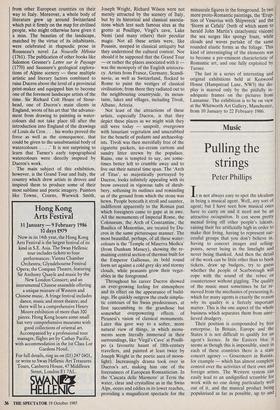Exhibitions
Images of the Grand Tour by Louis Ducros (1748-1810) (Kenwood House until 31 October)
Traveller's joy
David Wakefield
Louis Ducros is one of those fascinating minor masters of the late 18th century whose work illustrates the new perception of nature and landscape in Europe of that time, which finally resulted in the accept- ance of landscape painting as the supreme expression of Romanticism. Ducros's ori- gins were obscure. Born in 1748 in the canton of Vaud in Switzerland, he spent his youth in Yverdon on the shores of Lake Neuchkel. There he came in close touch with an active group of topographical artists, mostly from Berne and Lausanne, whose vivid and rather crude coloured etchings (so highly prized today) exerted a visible influence on Ducros's technique. Switzerland was by then firmly established in the repertory of 'picturesque' scenery, and therefore a focal point for all travellers from other European countries on their way to Italy. Moreover, a whole body of literature grew up around Switzerland which put it firmly on the map for civilised people, who might otherwise have given it a miss. The beauties of the landscape, matched by the virtue of its inhabitants, were celebrated in rhapsodic prose in Rousseau's novel La Nouvelle Heloise (1761). The publication of other books like Salomon Gessner's Lettre sur le Paysage (1770) and Saussure's geological explora- tions of Alpine scenery — these multiple artistic and literary factors combined to raise Ducros above the level of a provincial print-maker and equipped him to become one of the foremost landscape artists of the time. Sir Richard Colt Hoare of Stour- head, one of Ducros's main clients in England, wrote of his art that 'the advance- ment from drawing to painting in water- colours did not take place till after the introduction into England of the drawings of Louis du Cros . . . his works proved the force as well as the consequence, that could be given to the unsubstantial body of watercolours . . . .' It is not surprising to learn that Turner's early topographical watercolours were directly inspired by Ducros's work.
The main subject of this exhibition, however, is the Grand Tour and Italy, the country which drew artists in droves and inspired them to produce some of their most sublime and poetic imagery. Painters like Towne, Cozens, Warwick Smith, Joseph Wright, Richard Wilson were not merely attracted by the scenery of Italy, but by its historical and classical associa- tions which lent such famous sites as the grotto at Posillipo, Virgil's cave, Lake Nemi (and many others) their peculiar magic. Not all these artists were, like Poussin, steeped in classical antiquity but they understood the cultural context. Nor should it be supposed that the Grand Tour — or rather the places associated with it was the monopoly of the English aristocra- cy. Artists from France, Germany, Scandi- navia, as well as Switzerland, flocked to Rome to paint the vestiges of classical civilisation; from there they radiated out to the neighbouring countryside, its moun- tains, lakes and villages, including Tivoli, Albano, Ariccia.
Not least of the attractions of these artists, especially Ducros, is that they depict these places as we might wish they still were today — unspoilt, overgrown with luxuriant vegetation and unscrubbed for the benefit of pedants and archaeolog- ists. Tivoli was then mercifully free of the cigarette packets, ice-cream cartons and sundry litter strewn by the populace. Ruins, one is tempted to say, are some- times better left to crumble away and to live out their natural time span. The 'Arch of Titus', so majestically portrayed by Ducros, looks infinitely appealing with its brow covered in vigorous tufts of shrub- bery, softening its outlines and reminding us of the ground from which the stone was hewn. People beneath it stroll and saunter, indifferent apparently to the Roman past which foreigners came to gape at in awe. All the monuments of Imperial Rome, the Colosseum, the Arch of Constantine, the Basilica of Maxentius, are treated by Du- cros in the same picturesque manner. The most beautiful, perhaps, of all these water- colours is the 'Temple of Minerva Medica' (from Dunham Massey), showing the re- maining central section of thermae built for the Emperor Gallienus, its bold round form set against a cold grey sky and stormy clouds, while peasants grow their veget- ables in the foreground.
Throughout his career Ducros showed an ever-growing feeling for atmosphere and its effect on the appearance of build- ings. He quickly outgrew the crude simplis- tic contours of his Swiss predecessors, at first succumbing to the grandiose but somewhat overpowering effects of Piranesi's vision of classical monuments. Later this gave way to a softer, more natural view of things, in which monu- ments seem literally immersed in their surroundings, like `Virgil's Cave' at Posilli- po (a favourite haunt of 18th-century travellers, and painted at least twice by Joseph Wright in the poetic aura of moon- light). Increasingly drama took over in Ducros's art, making him one of the forerunners of European Romanticism. In the `Cascata delle Marmore' at Terni the water, clear and crystalline as in the Swiss Alps, oozes and eddies in its lower reaches, providing a magnificent spectacle for the minuscule figures in the foreground. In two more proto-Romantic paintings, the 'Erup- tion of Vesuvius with Shipwreck' and the `Storm at Cefahl' (both of which seem to herald John Martin's cataclysmic visions) the sea surges like spongy foam, while clouds and waves partake of the same rounded elastic forms as the foliage. This kind of intermingling of the elements was to become a pre-eminent characteristic of Romantic art, and one fully exploited by Turner.
The last in a series of interesting and original exhibitions held at Kenwood House (Hampstead Lane, NW3) the dis- play is marred only by the pitifully in- adequate frames on the pictures from Lausanne. The exhibition is to be on view at the Whitworth Art Gallery, Manchester, from 10 January to 22 February 1986.



















































 Previous page
Previous page